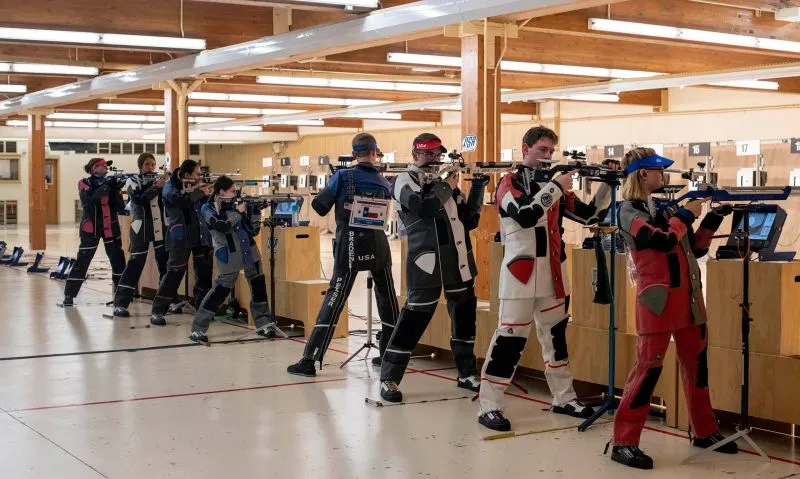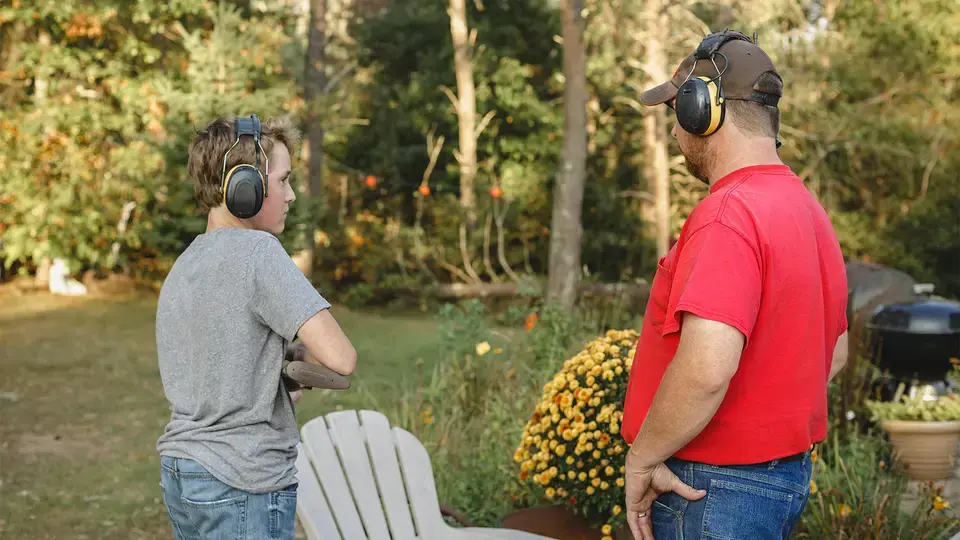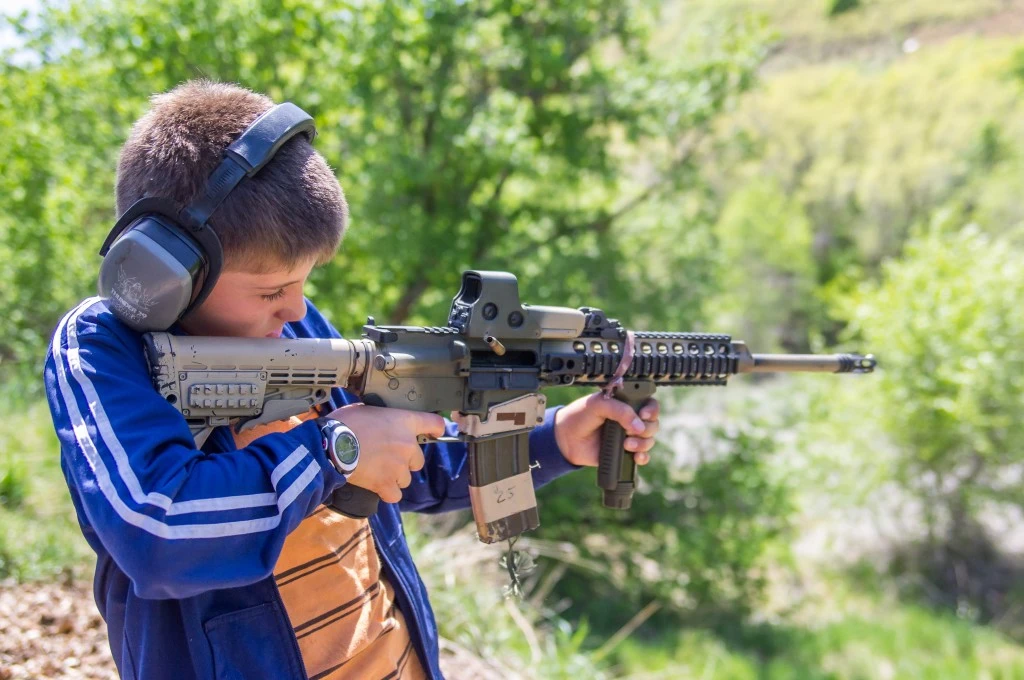
Last Updated on
The question of whether or not to introduce children to firearms remains relevant to this day. However, if you yourself are a gun owner, that question might be much easier to answer. If your child can, one way or another, gain access to a gun, it will be much better if the first time they do it they are under your supervision. In addition to teaching them yourself, you can enroll them in a junior shooting sports club. In this blog post, we’ll take a deep dive into the world of junior shooting sports, discussing its benefits and role in children’s upbringing, safety measures and how you, as parents, can support your child’s journey.
Table of Contents
Understanding the Basics
The Benefits of Junior Shooting Sports
The Role of Parents
Teaching Gun Safety to Kids
Choosing the Right Equipment
Opportunities and Platforms
Conclusion
FAQs

Understanding the Basics of Junior Shooting Sports
Junior shooting sports are a collection of competitive activities that involve firearms, tailored specifically for young participants. These sports are not so much about promoting physical activity (though this aspect is also important), but mostly about fostering discipline, responsibility and safety awareness among youngsters.
If you are unsure when to introduce children to firearms and shooting sports, then know there is no generally agreed-upon answer. Most experts do agree, however, that the decision should be reasoned by the child’s maturity level and their ability to understand and respect the rules of gun safety. As a rule, children can start learning about guns and shooting sports as early as eight years old. Most junior shooting sports programs accept kids aged 10 and above.
Though shooting sports themselves are extremely varied, the youth options are naturally more limited. With that being said, there are several types of shooting sports available for children, each with its unique set of rules and equipment. Here are a few examples:
- Air Rifle Shooting: As the name suggests, this sport features air rifles, which are much safer and easier to handle for young shooters than full-fledged firearms. Participants aim at stationary targets set at varying distances.
- Trap Shooting: In this sport, participants use shotguns to hit clay targets launched into the air. This sport is usually available only for older kids due to the heavier weight and recoil of shotguns.
- Sporting Clays: This is a form of clay pigeon shooting often described as ‘golf with a shotgun’. The sport involves shooting clay targets at multiple locations (stations) in a natural setting. Somewhat similar to trap shooting, but is nonetheless not the same.
- BB Gun Shooting: This sport is excellent for beginners. BB guns are low-power, smoothbore air guns that fire spherical projectiles. This sport is ideal for teaching basic gun handling and safety to children.
- Archery: While not a firearm-based sport, archery is often included in junior shooting programs as it teaches similar skills such as focus, precision, and discipline. Still is considered a shooting sport, so don’t discard it simply because it doesn’t involve a firearm.
Before enrolling children in any shooting sport, it’s vital to ensure they understand the importance of gun safety. Always supervise them during practice sessions and ensure they are using age-appropriate equipment.

The Benefits of Junior Shooting Sports
Many people expect shooting sports to be only about working on precision and speed shooting. While those skills are indeed considered to be a primary focus, junior shooting sports are much more than that. They act as a platform for developing a plethora of skills that can benefit children in all areas of their lives. Here’s a look at some of the key skills your child can develop through participating in shooting sports:
- Decision-Making: Much like a chess player contemplating their next move, shooting sports require participants to make quick, calculated decisions. Choosing when to take a shot, adjusting for wind speed and direction, or deciding the best stance to use all contribute to enhancing decision-making skills.
- Teamwork: Although shooting can be an individual sport, many events require participants to work as a team. This can help children learn how to collaborate, communicate effectively and understand the importance of shared goals.
- Self-Discipline: Everybody can benefit from the ability to follow self-imposed rules, and shooting sports are a great way to boost this ability. Regular practice, adherence to safety rules and the focus required to aim accurately all contribute to developing self-discipline.
- Self-Confidence: Few feelings can compare to the joy of hitting the bull’s eye. It’s a great boost to a child’s self-esteem, much like completing a challenging puzzle. As they see their skills improve with practice, children often feel a sense of achievement that enhances their confidence.
- Problem-Solving: Shooting sports present an array of challenges, from adjusting aim for distance and wind to overcoming nervousness in competition. Navigating these challenges can help children develop problem-solving skills.
- Sportsmanship: Like any other competitive sport, shooting teaches children about both winning and losing. They learn to celebrate victories with grace and accept defeats with resilience. Fostering a strong sense of sportsmanship is one of the greatest benefits of shooting sports.
In addition to these, shooting sports can also help improve mental skills like concentration and focus. Aiming at a target requires the shooter to block out distractions and focus solely on their target. With ads screaming for your attention from every screen, the ability to maintain your concentration comes in as an absolute necessity.
Moreover, shooting sports can foster a sense of responsibility in children. Handling firearms requires certain maturity and an understanding of the potential consequences. This can instill a strong sense of responsibility in children from a young age.

The Role of Parents in Junior Shooting Sports
Parental involvement is a critical component of any youth sport, and junior shooting sports are no exception. According to a study published by the National Center for Biotechnology Information, parents play a key role in introducing their children to physical activities and sports. They serve as the primary facilitators, providing both resources and moral support for their children.
Parents are children’s first teachers. When it comes to shooting in general, teaching by example is one of the most effective methods. This means demonstrating safe gun-handling practices and showing respect for rules and officials.
However, parental guidance goes beyond teaching technical skills and shooting etiquette. It also involves fostering a love for the sport and encouraging your child’s growth within it. As outlined in a publication by The Civilian Marksmanship Program, junior shooting programs should provide experiences that promote personal development. This means allowing children to take ownership of their learning, make decisions, and learn from their mistakes.
Yet, this independence should not compromise safety. The National Shooting Sports Foundation and the American Foundation for Suicide Prevention have worked together to address and prevent firearm-related incidents, emphasizing that parents have a crucial role in ensuring access to firearms is always under adult supervision. Remember: if your child knows where you keep your gun, they may very well get a hold of it one day, should you fail to store it securely.

Teaching Gun Safety to Kids
Before introducing kids to shooting sports or any activity that involves firearms, it’s crucial to first teach them gun safety. Even though children will learn about it at their first training, they will benefit greatly from knowing the basics beforehand. Making sure your child understands and respects these rules is the most important step in ensuring their safety and the safety of those around them. Here are Basic Gun Safety Rules: Kids Edition (4 basic + 3 for kids)
- If You Find a Gun, Don’t Touch It: It might sound counterintuitive to tell a child to never take a gun and then explain how to operate it. However, they don’t learn how to handle a gun to gain the right to take and use it however they like. While they are still children, they should only use guns that are given to them by adults. As such, touching any other gun should not be allowed.
- Treat Every Gun as if it’s Loaded: Children, at least small ones, rarely know how to check whether a gun is loaded or not. That’s why you should tell them that every gun should be treated as if it’s loaded. This includes never pointing it at anything you don’t intend to shoot and always being aware of where the muzzle is pointed.
- Never Touch a Gun Without Adult Supervision: Kids should be taught that they should never touch a firearm unless a responsible adult is present and has given them permission. It’s important to explain this in an approachable manner.
- Don’t Point a Gun at Anything You Don’t Intend to Shoot: This rule is fundamental to preventing accidents. Children should understand that guns aren’t toys and should never be pointed at people or pets.
- Keep Your Finger Off the Trigger Until Ready to Shoot: A key safety rule is to keep fingers away from the trigger until they’re ready to shoot. This helps prevent accidental discharges.
- Know Your Target and What’s Beyond It: Before taking a shot, it’s important to know not only what you’re shooting at, but also what’s behind it. Bullets can go through a target and hit something or someone beyond. Children may find the latter part hard to grasp, but understanding the first part is already good enough.
- Never Climb or Jump with a Gun: Kids are known for being active, and that doesn’t go too well with holding a firearm. Explain to them that if they are holding a gun, they shouldn’t run or jump.
Remember, repetition is key when it comes to safety training. Make sure to regularly review these rules with your child, and always model safe behavior when handling firearms yourself. By doing so, you can increase the chances of your child developing a strong respect for firearms and understanding the importance of safety.
Choosing the Right Equipment for Junior Shooting Sports
If you’ve decided to acquaint your child with firearms, presenting the one you own might be not the best idea. After all, firearms meant for hunting and self-defense can inflict deathly wounds, so any mishandling can be lethal. As such, selecting the appropriate equipment becomes a critical step when introducing children to shooting sports. The equipment should not only be suitable for the child’s age and size but also safe and easy to handle.
Type of Firearms for Kids:
Air Rifles: For younger ones who are just beginning, air rifles can be a great starting point. They are lighter and easier to handle than traditional firearms, which makes them perfect for teaching basic shooting principles without the fear of recoil or loud noise. Both pellets and BBs, while not entirely harmless, have much less destructive power than cartridges filled with gunpowder.
Rimfire Caliber Firearms: For older kids who have developed some proficiency and strength, rimfire firearms, particularly .22 caliber rifles, are often recommended. These guns provide a bit more power than air rifles but still have relatively low recoil, making them manageable for young shooters.
Beginner-Friendly Firearms and Gear:
Regular-sized rifles are likely to be too heavy for young hands to hold. As such, it’s better to opt for a model, designed specifically for youth. Some manufacturers dedicated models with smaller dimensions and lighter construction. Additionally, adjustable stocks can be a good feature to look for, as they allow the gun to grow with the child.
As for gear, a sturdy shooting rest can help stabilize the firearm and make it easier for young shooters to aim accurately. This can be particularly helpful for beginners who are still developing their shooting stance and technique.
Apart from that, safety gear should also be worn at all times. Ear protection and eye protection are an absolute must. Safety glasses protect the eyes from potential ricochets, while ear protection helps prevent damage from the loud noises produced by firearms.
Opportunities and Platforms for Junior Shooters
Now to the most informative part. Where can junior shooters learn about and engage in shooting sports? Two organizations can help them get acquainted with sports shooting: The American Legion and the one-and-only Boy Scouts of America.
The American Legion Junior Shooting Sports Program
The American Legion Junior Shooting Sports Program is a gun safety education and marksmanship course that covers the basic elements of firearm safety and education and intertwines them with enjoyment and the spirit of competition.
The program operates at both the local and national levels. At the local level, affiliated clubs can offer a variety of activities including basic marksmanship courses, competition opportunities, and even chances to qualify for the Junior Olympic Development Camp.
The National Championship is an annual air rifle tournament that provides top junior shooters from around the country with the opportunity to compete for scholarships and other awards. The competition includes both a precision category and a sporter category, catering to different levels of equipment and experience. In terms of weapons, the program exclusively uses .177 caliber air rifles.
Boy Scouts of America
The Boy Scouts of America (BSA) offers, apart from dozens of other things, a variety of shooting sports activities as part of their overall program. These activities are designed to be safe and instructive, teaching scouts marksmanship skills, the responsibilities of firearm ownership and the principles of hunting.
The BSA allows for the use of several types of firearms in their activities. This includes shotguns, muzzleloaders, and rifles. However, the specific rules regarding these firearms depend on the age of the scouts and the type of activity. For example, Cub Scouts (younger scouts) are only allowed to shoot BB guns and archery under direct adult supervision. At the same time, older scouts, while also being supervised, can use more advanced firearms: .22 caliber rifles, modern muzzleloaders and certain types of shotguns.
All shooting sports activities within the BSA must be supervised by a BSA-certified Range Safety Officer or NRA Range Safety Officer to ensure children are safe and properly instructed.
Conclusion
Such is our way of life that, sooner or later, most of us will interact with a gun, one way or another. It is smart to teach the basics of responsible gun ownership and usage from a young age. After all, it is irresponsible adults and criminals who tarnish the reputation of gun owners. Junior shooting sports are a great way to foster responsibility and awareness in the younger generation. Organizations like the American League and Boy Scouts can ensure that your child’s acquaintance with a gun grows into an all-weather friendship for years to come.
Also, read our guide to Texas Shooting Sports.
FAQs
What skills can young shooters learn from junior shooting sports?
Apart from learning about firearm safety, participants can develop skills in precision shooting, discipline, focus and responsibility.
Are there any competitive opportunities in Junior Shooting Sports?
Yes, many programs offer local, regional, and national competitions where young shooters can showcase their skills and compete for scholarships and awards. For example, the American League conducts an annual 3-Position Junior Air Rifle National Championship.
How do Junior Shooting Sports promote safety?
These programs emphasize safety training, and children are under constant supervision by trained adults. Strict adherence to safety rules is fostered among the mentees.





Leave a Reply